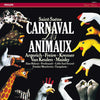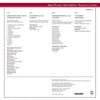



Saint-Saëns - Le Carnaval des Animaux - Ridout, Meschwitz (2LP, DMM)
Camille Saint-Saëns - Le Carnaval Des Animaux
Alan Ridout - Ferdinand (For Speaker And Solo Violin) & Little Sad Sound (A Melodramma For Speaker And Double-bass)
Frieder Meschwitz - Tier-Gebete [Animal's Prayers] (For Speaker And Piano)
Piano - Martha Argerich (A1-14), Nelson Freire (A1-14), Elena Bashkirova (C1)
Violin - Gidon Kremer (A1-14, B1), Isabelle van Keulen (A1-14)
Viola - Tabea Zimmermann (A1-14)
Violoncello - Mischa Maisky (A1-14)
Double-bass - Georg Hortnagel (A1-14)
Flute - Irena Grafenauer (A1-14)
Clarinet - Eduard Brunner (A1-14)
Xylophone - Markus Steckeier (A1-14)
Glockenspiel - Edith Salmen-Weber (A1-14)
Double-bass - Alois Posch (D1)
Speaker - Elena Bashkirova (B1, C1), Gidon Kremer (C1, D1)
2 LPs, Gatefold jacket
Direct Metal Mastering (DMM)
Original analog Master tape : YES
Heavy Press : 180g
Record color : black
Speed : 33 RPM
Size : 12'’
Stéréo
Studio
Record Press : Pallas GmbH in Germany
Label : Analog Phonic
Original Label : Philips
Recorded in Munich in April 985 («Carnaval») and April 1981 («Ferdinand», »Tier-Gebete«); and Wien in January 1987 (“Little Sad Sound”)
Engineered by Wil-helm Hellweg
Recording engineers: Roger de Schot, Onno Scholtze
Produced by Rupert Fäustle
Tape editors: Roger de Schot, Willem van Leeuwen
Remastered by Hans-Jörg Mauksch at Pauler Acoustics from the original masters of Universal Music
Originally released in 1988
Reissued in 2018
Tracks:
Side A : Le Carnaval Des Animaux
- Introduction Et Marche Royale Du Lion
- Poules Et Coqs
- Hémiones (Animaux Véloces)
- Tortues
- L'Eléphant
- Aquarium
- Personnages à Longues Oreilles
- Le Coucou Au Fond de Bois
- Volières
- Pianistes
- Fossiles
- Le Cygne
- Final
Side B :
- Ferdinand
Side C :
- Tier-Gebete
Side D :
- Little Sad Sound
Reviews :
« Everything is clear. Rhythms spring. Individuals get to leave their cherry bombs on the doorstep or to sing beauti-fully. Argerich and Freire, for example, outrageously mug up "Pianistes," rhythmically pulling the pianos ever more wildly out of sync, and then bringing them back together with a bang at the "coda." Irena Grafenauer's flute chirps merrily in "Volieres." Eduard Brunner on clarinet emits the cuckoo's cry from the middle of the deep woods. I've rarely heard it sound so lonely. Overall, the performance blends extremely high musicianship with kiddie rough-house. » - Classical.net
Direct Metal Mastering
In Direct Metal Mastering, the cutting lathe engraves the audio signal directly onto a copper-plated master disc, instead of engraving the groove into a lacquer-coated aluminum disc.
The direct metal mastering technology addresses the lacquer mastering technology's issue of pre-echoes during record play, caused by the cutting stylus unintentionally transferring some of the subsequent groove wall's impulse signal into the previous groove wall. In particular, a quiet passage followed by a loud sound often clearly revealed a faint pre-echo of the loud sound occurring 1.8 seconds ahead of time (the duration of one revolution at 33 rpm). This problem could also appear as post-echo, 1.8 seconds after a peak in volume.
Another improvement is noise reduction. The lacquer mastering method bears a higher risk of adding unwanted random noise to the recording, caused by the enclosure of small dust particles when spraying the silvering on the lacquer master, which is the necessary first step of the electroplating process for reproduction of the master disc. As the DMM master disc is already made of metal (copper), this step is not required, and its faults are avoided.
With the groove being cut straight into a metal foil, this removed a number of plating stages in the manufacturing process. This gave rise to more upper frequency levels and less surface noise. Additionally, groove pre-echo problems are significantly diminished. Bass is typically tight and well defined, even described as more accurate than the fat, mushy sound of lacquered vinyl pressings.
Rating :
Discogs : 4,73 / 5

